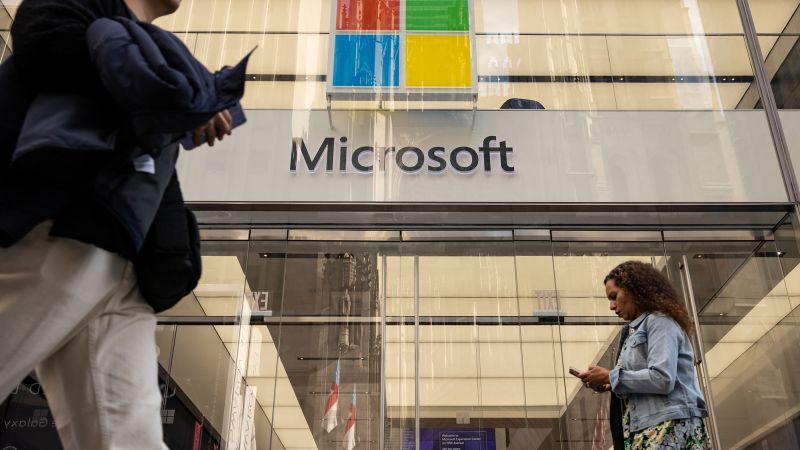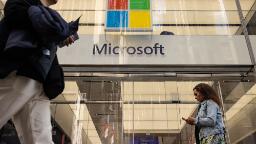

New York
CNN
—
Big tech companies are continuing a turnaround from last year, as Alphabet, Microsoft and Snap kicked off earnings season with strong sales results for the quarter ended in September.
Google parent company Alphabet on Tuesday reported quarterly sales of $76.69 billion, up 11% from the same period in the prior year. The company also posted profits of $19.69 billion for the quarter.
Meanwhile, Microsoft posted 13% year-on-year sales growth to $56.5 billion, also beating expectations. Microsoft’s quarterly profits hit $22.3 billion, up 27% from the year-ago period.
Snapchat parent Snap on Tuesday reported a return to sales growth in the September quarter, after two consecutive quarters of declining sales. The company reported revenue of nearly $1.2 billion, an increase of 5% from the same period in the prior year and ahead of analysts’ projections. The company reported a net loss of $368 million.
The strong results come after Microsoft, Alphabet, Snap and other tech companies carried out mass layoffs and other cost cutting moves over the past year following a difficult 2022 when advertisers and other clients cut back on their spending due to concerns over the macroeconomic environment.
Despite beating Wall Street’s sales expectations, shares of both Alphabet and Snap each dipped around 5% in after-hours trading following the reports, although Snap’s quickly regained some ground. Microsoft’s shares gained around 4% in after-hours trading.
“Q3 tech season has been quite strong thus far,” Tejas Dessai, research analyst at investment fund GlobalX said in a statement. “These numbers clearly defy concerns of near term economic weakness looming.”
Google’s advertising business generated quarterly revenue of $59.6 billion, up from $54.5 billion in the prior year. YouTube ads, meanwhile, garnered some $7.9 billion in revenue, up roughly 12% year-over-year.
YouTube Shorts, the company’s TikTok competitor, hit a milestone 70 billion daily views last quarter, Alphabet CEO Sundar Pichai said on a call with analysts Tuesday afternoon.
Google’s cloud business, however, reported revenue of $8.41 billion — missing analysts’ estimates.
Jesse Cohen, a senior analyst at Investing.com, attributed Alphabet’s after-hours stock fall to the “relatively weak performance in its Google cloud platform, which is at risk of falling further behind [Microsoft’s] Azure and [Amazon’s] AWS.” Still, despite taking a hit in 2022 amid a broader tech sector downturn, shares for Alphabet have climbed roughly 57% since the start of 2023, beating the tech-heavy Nasdaq index.
Google’s report comes as the tech giant is in the antitrust hot seat. US prosecutors officially opened a landmark antitrust trial against Google last month with sweeping allegations that the company engaged in anticompetitive behavior to maintain its dominance over search. (As the legal showdown rages on, Google has continued to deny allegations that it operated illegally.)
Google also confirmed last month plans to lay off hundreds of staffers in its recruiting division, as it continues cost cutting efforts in some areas. These more targeted layoffs came after Alphabet in January cut around 12,000 jobs — about 6% of its workforce.
Still, Google has signaled that it remains committed to investing heavily in generative AI technology. Last month, Google rolled out a major expansion of its Bard AI chatbot tool.
“As we expand access to our new AI services, we continue to make meaningful investments in support of our AI efforts,” Pichai said on the call. “We remain committed to durably re-engineering our cost base in order to help create capacity for these investments, in support of long-term sustainable financial value.”
Microsoft’s recent investments in artificial intelligence technology helped boost its sales in the September quarter, especially in its key cloud division. Sales from Microsoft’s “intelligent cloud” business — its biggest revenue driver — grew 19% from the year-ago quarter to $24.3 billion.
Revenue from the company’s “productivity and business processes” business, which includes LinkedIn and Office commercial and consumer products, also grew 13% year-over-year to $18.6 billion.
“Microsoft is firing on all cylinders and AI is clearly driving growth,” Cohen said in a research note following the company’s report. “The results indicated that artificial intelligence products are stimulating sales and already contributing to top and bottom-line growth.”
But economic jitters among consumers appear to still have some impact on the company’s bottom line. Devices revenue, which includes sales of laptops, tablets and Xbox consoles, decreased 22% year-over-year, despite a 3% sales increase in the overall “more personal computing” segment. Ongoing concerns about a potential economic slowdown could continue to weigh on the company as it heads into the crucial holiday device sales season.
The report is Microsoft’s first since the company closed its $69 billion acquisition of “Call of Duty” maker Activision Blizzard earlier this month. While the deal didn’t factor into this quarter’s results, it’s expected to supercharge the company’s gaming business.
“Microsoft now controls 30 game studios and some of the most well-known games across the industry,” Edward Jones analyst Logan Purk said in a research note earlier this month. “With a massive cloud network and now a compelling library of games, Microsoft has a leg up on peers” in gaming, he said.
Snap said its sales growth was driven in part by its ongoing efforts to revamp its advertising technology, following changes to Apple’s app tracking policies that took a hit to the business models of Snapchat, Facebook and other platforms.
“We are focused on improving our advertising platform to drive higher return on investment for our advertising partners, and we have evolved our go-to-market efforts to better serve our partners and drive customer success,” CEO Evan Spiegel said in a statement.
Snap also reported that it now has 406 million daily active users, up 12% compared to the year-ago quarter. And time spent watching Spotlight — Snapchat’s TikTok clone — grew 200% year-over-year, according to the company.
The company also recently announced that it had reached more than 5 million subscribers to its Snapchat+ subscription program, a key effort to diversify its revenue.
Snap said Tuesday that its chief operating officer, Jeremy Hunter, plans to retire. Hunter, who spent seven years at the company, will step down from his role as of the end of the month, but will remain at the company until July 1, 2024, to support the transition.
The company noted that some advertisers temporarily paused their spending following the outbreak of the Israel-Hamas war. Because of the “unpredictable nature” of the war, Snap declined to provide formal guidance for the fourth quarter, but said its internal forecast assumes year-over-year quarterly revenue growth between 2% and 6%.
